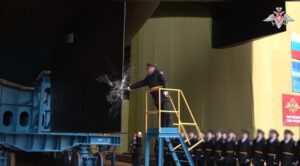Severodvinsk, 1 November 2025 - The nuclear-powered submarine "Khabarovsk" (project 09851) has been launched at the shipyard of the Sevmash production association. According to the Russian Ministry of Defence, it is the first series-produced carrier of the autonomous nuclear torpedo "Poseidon". Unlike the "Belgorod", which was built as an individual conversion, the "Khabarovsk" marks the start of a standardised production line for this new category of weapon.
Ceremony led by the Minister of Defence

The launching ceremony was attended by Defence Minister Andrei Beloussov and the new Commander-in-Chief of the naval fleet, Admiral Alexandr Moiseyev. Beloussov emphasised the importance of the boat for Russia's maritime security architecture in strategically relevant sea areas. Admiral Moiseyev referred to the submarine's design for operations in extreme Arctic conditions. Remarkably, Beloussov described the "Khabarovsk" in his speech as a "heavy nuclear-powered missile cruiser" - a classification that points to the ongoing secrecy surrounding Project 09851.
Second Poseidon carrier after the "Belgorod"
After the "Belgorod" (project 09852, Entry into service 2022) is the second submarine for the deployment of the new weapon system. Construction of the "Khabarovsk" began in 2014 and, unlike the converted "Belgorod", it was designed for the Poseidon mission from the outset. The design is based on a shortened hull of strategic submarines, but completely dispenses with silos for ballistic missiles. A third Poseidon carrier, the "Ulyanovsk" (project 09853), has also been under construction at Sevmash since 2017.
Key technical data of the "Khabarovsk"

According to estimates, the displacement of the boat is around 10,000 tonnes (surfaced), the length between 113 and 120 metres. The crew probably comprised around 100 men. It is officially confirmed that it is armed with six Poseidon torpedo drones. The Poseidon drones are launched via large-calibre bow launch tubes, similar to the architecture of the "Belgorod". The boat also has conventional torpedoes for self-defence. The stern became visible for the first time during the launch - the published photos show a pump-jet propulsion system. The forecastle remained completely covered. A tactical identification number like that of the "Belgorod" (K-329) has not yet been communicated. After completion of the test phase, commissioning is planned for the end of 2026. The "Khabarovsk" will then be assigned to the Pacific Fleet, while "Belgorod" and "Ulyanovsk" are intended for the Northern Fleet.
The Poseidon system: strategic underwater drone
The main armament of these boats is the "Doomsday drone" Poseidon (former Russian designation "Status-6", NATO code Kanyon), whose function was successfully tested a week ago, according to Russian President Vladimir Putin. Poseidon is a 20 to 24 metre long, nuclear-powered autonomous underwater glider with a thermonuclear warhead. Russian specifications speak of an intercontinental range. The speed is said to be up to 50 knots and the operational depth up to 1,000 metres. The warhead's explosive power is estimated at two to ten megatonnes.
Designed as a second strike weapon, Poseidon is intended to attack enemy coastal infrastructure. President Vladimir Putin presented the system on 1 March 2018 and used a computer animation to illustrate a scenario in which entire coastal regions are devastated by a tsunami as a result of a thermonuclear underwater detonation triggered by Poseidon.
From the Oscar-II to the special platform: the "Belgorod"
By way of comparison, the "Belgorod" was originally launched in 1992 as an Oscar II-class submarine (project 949A/949B "Antey", 154 metres, 18,000 tonnes submerged). At 75 per cent completion, the project was stopped at the end of the 1990s. The hull lay unused at Sevmash for years until the decision was made in 2012 to convert it for special tasks - this resulted in project 09852 with significantly larger parameters.
The "Belgorod" (185 metres, 27,000 tonnes submerged) functions not only as a weapons carrier, but also as a carrier platform for the Deep Sea Research Directorate (GUGI). It can transport mini-submarines such as the "Losharik" under the hull and deploy underwater infrastructure (such as the Harmony sonar network). This multifunctionality required design compromises. The smaller, or normal-sized "Khabarovsk", on the other hand, was specially optimised for Poseidon operations.
New maritime deterrent component beyond the triad
In contrast to conventional strategic submarines (SSBNs), the "Belgorod" and "Khabarovsk" (and in future the "Ulyanovsk") do not have ballistic missiles (SLBMs). They form an independent nuclear component outside the traditional triad, which was previously based on sea-based ballistic missiles. With the unique "Belgorod" and the two newbuildings "Khabarovsk" and "Ulyanovsk", a separate pillar of maritime nuclear deterrence is being created.
According to Russian sources, Moscow is planning a total of four poseidon-capable submarines for the North and Pacific fleets. According to official documents, local reporting and mentions in social networks, the submarine "Orenburg" (also project 09853) has already been ordered and is in the shipyard preparation phase (keel laying) (Sevmash) as of autumn 2025.
Russia expands its strategic room for manoeuvre
The deployment of these systems in Arctic waters expands the Russian fleet's tactical and strategic options, especially as the deployment of the Poseidon torpedo drone does not depend on breaking through the ice cover, as the launch of strategic nuclear weapons did previously. This considerably intensifies the threat situation for North America and Europe. In view of Poseidon's technical parameters - range, deployment time, diving depth - a new form of maritime deterrence is emerging that is difficult to grasp and whose political signalling effect goes beyond the technical dimension.
The coming months will show whether the system proves to be operational - or primarily serves as a geopolitical instrument of pressure in an increasingly asymmetrical security policy constellation. One thing is certain: with "Khabarovsk" and its sister ships, Russia is pursuing the goal of diversifying its underwater nuclear options - and redefining the limits of classic deterrence logic at sea.










